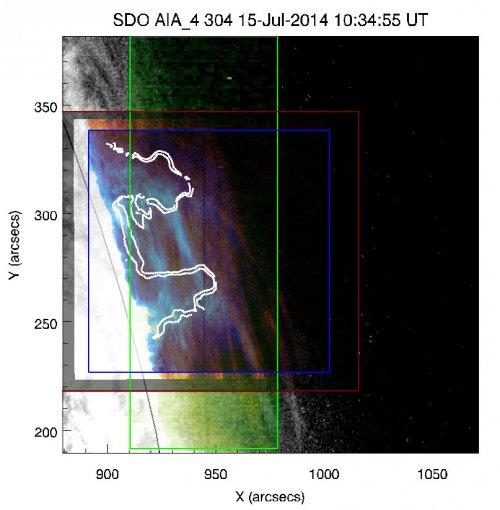Solar tornadoes are not tornadoes!
Against all appearances, the “solar tornadoes” do not turn. This is the conclusion of the work carried out by a team of European researchers including an IRAP astronomer (CNRS & Université Paul Sabatier de Toulouse), and reported on Friday 6 April 2018, at the European Week of Astronomy and Space Science (EWASS) conference in Liverpool.

A recent analysis of solar tornadoes, those structures observed on the surface of the Sun, gigantic by their size and which can reach several times that of the Earth, shows that this phenomenon was badly described, because observed only on images in two dimensions. The phenomenon was first observed in the early 20th century on the surface of the Sun. More recently, it has been filmed closely using instruments such as AIAs on NASA’s SDO (Solar Dynamics Observatory) probe, but continued to be wrongly called “tornado” by scientists. The films indeed show a very hot plasma, visible in ultraviolet light, which apparently turns on itself forming giant structures, like the tornadoes that occur on Earth.
To understand this phenomenon in more detail, scientists then sought to obtain a third dimension by combining observational data collected over several years on different types of ground instruments (Paris Observatory solar tower, Paris Observatory spectroheliograph, Teide Observatory solar telescope) and in space (SDO, Hinode and IRIS satellites). By determining the Doppler effect, they were able to calculate the velocity of the plasma (40 kilometres per second) as well as the direction of its motion, temperature and density. They have thus succeeded in “reconstructing” the complete magnetic structure that supports these giant masses. They concluded that these structures were well known elsewhere and studied under the name of “protuberances”.
The solar giant tornadoes, now renamed “tornado protuberances”, were first observed on the Sun about a century ago. They had been so named because of the apparent movement of their rotation, similar to that of terrestrial tornadoes, but this perception was wrong. In fact, the comparison with terrestrial tornadoes is abusive. While these lat ones are caused by intense winds, the solar protuberances-tornads are formed from magnetized gases rooted beneath the Sun’s surface, without displacement. These are actually the feet of the protuberances.” For once, reality is much simpler than we thought we were seeing,” says Brigitte Schmieder, an astronomer at the Paris Observatory – PSL. We see that despite the vertical appearance of tornadoes and protuberances at the edge of the Sun, the magnetic field that supports them is not vertical, as it seemed, but horizontal, parallel to the edge of the Sun. Their apparent verticality is an effect due to the projection of all structures on the plane of the sky.” explains Nicolas Labrosse, a researcher at the University of Glasgow (School of Physics and Astronomy).
“This effect is similar to the trails of an airplane left in the sky. If the aircraft still flies at the same altitude, its trail seems to stop on the horizon line. This does not mean that the aircraft crashed to the ground. ” Arturo López Ariste, CNRS researcher at the Institut de Recherche en Astrophysique et Planétologie (University of Toulouse), explains. These protuberances-tornadoes can be stable for several days and months, before exploding and causing coronal mass ejections whose consequences in the terrestrial environment are known under space weather,” underlines Brigitte Schmieder. “They can cause disturbances in power plants, satellites and communications networks on Earth.”
Further Resources
These different research works gave rise to several publications :
- B. Schmieder, M. Zapior, A. Lopez Ariste, P. Levens, N. Labrosse, R. Gravet, “Reconstruction of a helical prominence in 3D from IRIS spectra and images” ; A&A, 606, A30 (2017).
- B. Schmieder, P. Mein, N. Mein, P. Levens, A. Lopez Ariste, N. Labrosse, L. Ofman, “H alpha Doppler shifts in a tornado in the solar corona” ; A&A, 597, 109 (2017)
- P. Levens, B. Schmieder, N. Labrosse, A. Lopez Ariste, “Structure of prominence legs : plasma and magnetic fields” ; ApJ, 818, 31 (2016)
- P. Levens, B. Schmieder, A. Lopez Ariste, N. Labrosse, K. Dalmasse, B. Gelly, “Magnetic field in atypical prominences : Bubble, tornado and eruption” ; ApJ, 826, 164 (2016)
- P. Levens, N. Labrosse, B. Schmieder, A. Lopez Ariste, L. Fletcher, “Comparison between UV/EUV line parameters and magnetic field parameters in a quiescent prominence with tornadoes” ; A&A, 607, A16 (2017)
- Vidéo : Les tornades solaires ne sont pas des tornades
IRAP Contact
- Dr Arturo López Ariste, Institut de Recherche en Astrophysique et Planétologie, Université de Toulouse, CNRS, CNES, France






